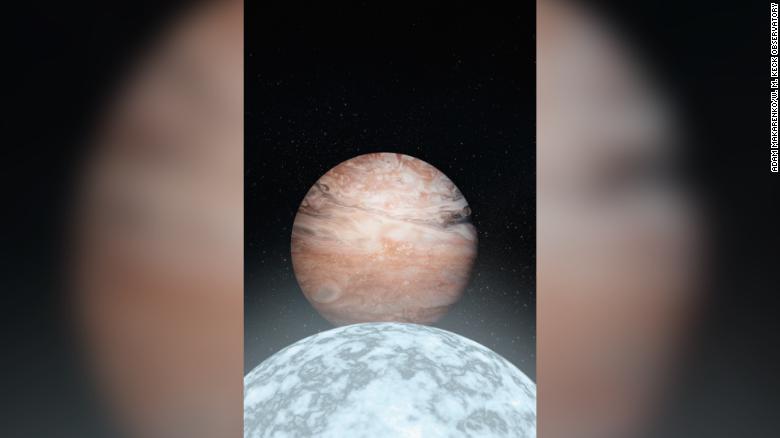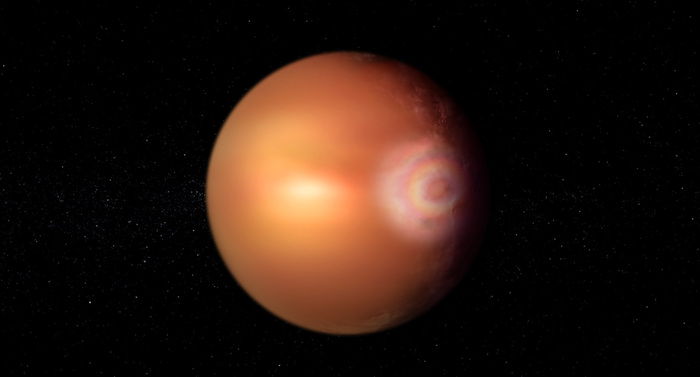These planets would survive the death of the Sun 1:10
(CNN) -
The discovery of a distant Jupiter-like planet orbiting a dead star reveals what could happen in our solar system when the Sun dies in about 5 billion years, according to new research.
This unusual duo was discovered 6,500 light years away, near the center of our Milky Way.
The pairing is unexpected because this gas giant exoplanet with a mass similar to that of Jupiter orbits a white dwarf.
A white dwarf is what remains after a Sun-like star turns into a red giant during its evolution.
The red giants burn their hydrogen fuel and expand, consuming any nearby planet in their path.
When the star loses its atmosphere, all that remains is the collapsed core, that is, the white dwarf.
This remnant, normally the size of Earth, continues to cool for billions of years.
This is what planets outside the solar system would look like 0:44
The finding of an intact planet orbiting a white dwarf raises questions about how it survived the star's evolution into a white dwarf.
By looking at the system, the researchers were able to determine that the planet and the star formed around the same time and that the planet survived the death of the star.
The planet is about 2.8 AU from the star.
An AU, or astronomical unit, is the distance between the Earth and the Sun, or 148 million kilometers.
Previously, scientists believed that gas giant planets had to be much farther away to survive the death of a sun-like star.
advertising
The findings of a new study, published Wednesday in the journal Nature, show that planets can survive this incredibly violent phase of stellar evolution and support the theory that more than half of white dwarfs likely have similar planets orbiting them. of them.
This artist's rendering shows a star experiencing the red giant phase, when it burns off the remnant of its nuclear fuels before collapsing in on itself to form a smaller, weaker white dwarf.
"This test confirms that planets orbiting at a sufficiently great distance can continue to exist after the death of their star," said Joshua Blackman, lead author of the study and a postdoctoral researcher in Astronomy at the University of Tasmania in Australia, in a statement. .
"Since this system is an analog to our own solar system, it suggests that Jupiter and Saturn could survive the red giant phase of the Sun, when it runs out of nuclear fuel and self-destructs."
White dwarfs and the future of Earth
When our Sun becomes a red giant billions of years from now, it is likely to engulf Mercury and Venus ... and perhaps Earth.
"The future of Earth may not be so promising because it is much closer to the Sun," said David Bennett, study co-author and principal research scientist at the University of Maryland and NASA's Goddard Space Flight Center, in a statement. .
"If humanity wanted to move to a moon of Jupiter or Saturn before the Sun fries the Earth during its red supergiant phase, we would continue to orbit the Sun, although we could not count on the Sun's heat as a white dwarf for long. weather".
The Jupiter-like planet was previously discovered using a technique called gravitational microlensing, which is used to detect cold planets that are far from their stars.
This same technique can be used to find small, faint white dwarfs.
Gravitational microlensing occurs when a star near Earth briefly aligns itself with another farther away.
The gravity of the nearest star acts like a magnifying glass that enhances the light of the farthest star.
The researchers used Hawaii's WM Keck Observatory as well as their infrared camera to observe the white dwarf and the planet.
The white dwarf is 60% the mass of our sun, and the planet is 40% more massive than Jupiter.
This artist's rendering shows Jupiter orbiting our sun once it becomes a white dwarf.
The high-resolution images on the infrared sensor allowed the researchers to rule out the possibility that what orbits the exoplanet is a normal star or another type of evolving star.
"We have also been able to rule out the possibility that it is a neutron star or a black hole. This means that the planet is orbiting a dead star, a white dwarf," said study co-author Jean-Philippe Beaulieu, Professor of Astrophysics at the University of Tasmania and director of research at the Paris Institute of Astrophysics of the National Center for Scientific Research, in a statement.
"It offers a vision of what our solar system will be like after the disappearance of the Earth, annihilated in the cataclysm of our Sun."
Prince William: great minds should focus on saving Earth
More surviving planets around white dwarfs
So far, only giant planets have been detected around white dwarfs, but that doesn't mean they are the only planets that exist around these dead stars.
"There should also be lower mass planets orbiting white dwarfs," Bennett wrote in an email.
"Our microlensing studies detect a similar number of [planets like] Jupiter and Neptune, but we are more sensitive to 'Jupiters.' Thus, we have found that planets with similar mass to Neptune are about 10 times more common than planets. "Jupiter" in the widest orbits that will survive the final stages of stellar evolution. We hope to find planets of different masses orbiting white dwarfs. "
"We hope to find mass-range planets orbiting white dwarfs, but smaller rocky planets in close orbits are more likely to have been smashed to pieces during the red giant phase of their host star's evolution," Blackman added.
Researchers will continue the search for surviving exoplanets orbiting dead stars in the future.
The Nancy Grace Roman Space Telescope, scheduled to launch in 2026, "will conduct a much more sensitive microlensing study that should find many more planets orbiting white dwarfs," Bennett said.
The Roman space telescope, more powerful than Hubble, promises to unravel space mysteries
The telescope will take direct images of the giant planets and study the planets that orbit the white dwarfs in our galaxy, allowing scientists to better understand how many are destroyed by stellar evolution and how many survive.
In recent years, other giant planets have been found orbiting dead stars, including one that is slowly being consumed by its zombie star, as well as a giant planet closely orbiting a white dwarf.
"The news that another planet was found orbiting a white dwarf is exciting as it offers further proof that planets exist around dead stars, after our article last year reported on the first one to be found," said Lisa. Kaltenegger, director of the Carl Sagan Institute at Cornell University.
Kaltenegger was not involved in the new study.
They discover a giant planet orbiting a dead white dwarf star
Although this particular planet is unlikely to be potentially habitable, much research has been done around the idea of looking for life on planets that could orbit white dwarfs.
"If planets can survive the disappearance of their star, could life too? The James Webb Space Telescope, due to launch soon, could answer this question," says Kaltenegger.
"If life could survive even on planets that revolve around stellar corpses, that would be an amazing future for our cosmos."
StarPlanet



/cloudfront-eu-central-1.images.arcpublishing.com/prisa/PA5TT2ZCYBDNLEAREMUPESRVOM.jpg)









